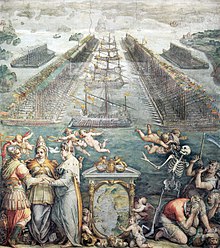The Battle of Lepanto: A Historic Naval Clash
Introduction:
On October 7, 1571, the historic Battle of Lepanto took place. It was among one of the most significant naval engagements in human history. The conflict symbolized the climactic end to the age of galley warfare in the Mediterranean, which had been a battleground for centuries, marking a turning point that significantly shifted power dynamics in Europe.
Background:
In the 16th century, the Mediterranean Sea was a disputed territory with the Christian maritime republics on the northern coasts and the Ottoman Empire controlling the south. The rising tension culminated in a broad alliance of Christian states known as the Holy League, spearheaded by Pope Pius V. The Holy League, consisting of Spain, Venice, and the Papal States among others, aimed to curb the expansion of the Ottoman Empire.

The Event – Battle of Lepanto:
On October 7, 1571, a fleet of the Holy League, commanded by Don John of Austria, met the Ottoman fleet near the Gulf of Patras, close to Lepanto (modern-day Nafpaktos), Greece. Both sides consisted of triremes or galleys, a type of ship powered primarily by rowers. The Christian fleet had around 212 ships and about 30,000 men, whereas the Ottoman fleet was composed of about 250 ships and around 31,000 men.
The battle lasted for about five hours, with both sides firing cannons and boarding each others’ ships. However, the superior number and quality of the Holy League’s artillery eventually led to a decisive victory over the Ottomans, who lost almost 230 galleys and 20,000 men.
Impact:
The Battle of Lepanto marked the end of the Ottoman Empire’s naval dominance in the Mediterranean. Despite the loss, the Ottoman Empire quickly rebuilt its fleet but never regained its prior naval supremacy.
Interesting Facts For Kids:
1. The term ‘Lepanto’ is Italian for Naupactus, the modern-day town in Greece near where the battle happened!
2. The Battle of Lepanto was the last significant battle almost entirely fought between fleets of galleys, a type of ship used for over two millennia.
Educational Activities For Kids:
1. Create a diorama to represent the Battle of Lepanto. This will enable kids to understand the scale and landscape of the historic clash better.
2. Write a ‘Diary of a Sailor’, which can help children explore and express feelings of the mariners who experienced this monumental battle firsthand.
Conclusion:
The Battle of Lepanto, on October 7, 1571, serves as a historic testament to the shifts in power and tactics during the late 16th century. A convergence point of faith, warfare and strategy, it remains a pivotal point of study for those interested in the ebb and flow of global hegemonies.
References:
1. Braudel, Fernand. (1995). The Mediterranean and the Mediterranean World in the Age of Philip II, Vol. II. New York: Harper & Row
2. Currey, E. Hamilton. (1923). Sea-Wolves of the Mediterranean. London: John Murrey.







What do you think?
Show comments / Leave a comment